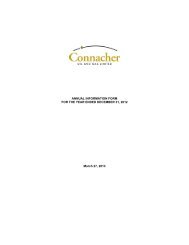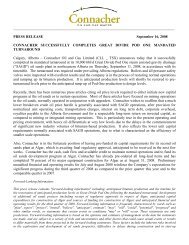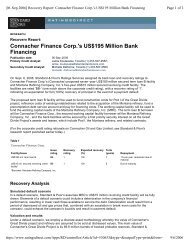ANNUAL REPORT 2011 - Connacher Oil and Gas
ANNUAL REPORT 2011 - Connacher Oil and Gas
ANNUAL REPORT 2011 - Connacher Oil and Gas
You also want an ePaper? Increase the reach of your titles
YUMPU automatically turns print PDFs into web optimized ePapers that Google loves.
AR <strong>2011</strong><br />
PG 53<br />
Goodwill is allocated to the applicable cash–generating unit as defined in note 3.6. Goodwill is not amortized <strong>and</strong> is tested for impairment annually<br />
on December 31 or whenever there is an indication that the cash-generating unit to which goodwill is allocated may be impaired, in accordance with<br />
note 3.6.<br />
3.6 Impairment<br />
Non–financial assets (E&E, PP&E <strong>and</strong> Goodwill)<br />
When impairment indicators exist or when impairment testing is required for non–financial assets, an impairment test is carried out in which the<br />
carrying amounts of those assets are compared to their recoverable amount, which is the higher of fair value less costs to sell (“FVLCS”) <strong>and</strong> value–<br />
in–use (“VIU”). For purposes of the impairment test, E&E, PP&E <strong>and</strong> goodwill are grouped together into the smallest group of assets that generates<br />
largely independent cash flows from other assets or groups of assets (the “cash–generating unit” or “CGU”).<br />
VIU is determined by estimating the discounted future cash flows expected to be derived from continuing use of the assets. In determining FVLCS,<br />
recent market transactions are taken into account, if available. If no such transactions can be identified, an appropriate valuation model is used. These<br />
calculations are corroborated by valuation multiples or other available fair value indicators.<br />
Impairment losses are recognized in net earnings (loss) <strong>and</strong> reported within depletion, depreciation, amortization <strong>and</strong> impairment. Impairment losses<br />
recognized in respect of a CGU are allocated first to reduce the carrying amount of any goodwill allocated to the CGU <strong>and</strong> then to reduce the carrying<br />
amount of the other assets in the CGU.<br />
An impairment loss in respect of goodwill is not reversed. In respect of other assets, impairment losses recognized in prior years are assessed at each<br />
reporting date for any indications that the loss has decreased or no longer exists. If the amount of the impairment loss decreases in a subsequent<br />
period <strong>and</strong> the decrease can be objectively related to an event occurring after the impairment was recognized, the impairment loss is reversed up to the<br />
original carrying amount of the asset that would have been determined, net of depletion, depreciation, amortization <strong>and</strong> impairment, if no impairment loss<br />
had been recognized. Such reversal is recognized in net earnings (loss) <strong>and</strong> reported within depletion, depreciation, amortization <strong>and</strong> impairment.<br />
Financial assets (Cash, Trade <strong>and</strong> accrued receivable <strong>and</strong> Investment in equity securities)<br />
A financial asset not carried at fair value through profit or loss is assessed at each reporting date to determine whether there is objective evidence<br />
that it is impaired. A financial asset is impaired if objective evidence indicates that a loss event has occurred after the initial recognition of the asset,<br />
<strong>and</strong> that the loss event had a negative effect on the estimated future cash flows of that asset that can be estimated reliably.<br />
The company considers evidence of impairment for trade <strong>and</strong> accrued receivables at a specific asset level. All individually significant trade <strong>and</strong><br />
accrued receivables are assessed for specific impairment. An impairment loss is calculated as the difference between its carrying amount <strong>and</strong> the<br />
present value of the estimated future cash flows discounted at the asset’s original effective interest rate. Losses are recognized in net earnings (loss)<br />
<strong>and</strong> reflected in an allowance account against trade <strong>and</strong> accrued receivables. When a subsequent event causes the amount of impairment loss to<br />
decrease, the decrease in impairment loss is reversed through net earnings (loss).<br />
3.7 Investment in associate<br />
An associate is an entity over which the company has the right to exercise significant influence, but not control, over the financial <strong>and</strong> operating<br />
policies. The investment in associate is accounted for using the equity method of accounting. Under the equity method, the investment is initially<br />
recorded at cost <strong>and</strong> subsequently adjusted for the post–acquisition changes in the company’s share of net assets of associate, after adjustment to<br />
align the accounting policies with those of the company. The company’s net earnings or loss reflects the company’s share of the net earnings or loss<br />
after tax of the associate.<br />
The company assesses the investment in associate for impairment whenever events or changes in circumstances indicate that the carrying amount<br />
may not be recoverable. If any such indication of impairment exists, the carrying amount of the investment is compared with its recoverable amount,<br />
being the higher of its fair value less costs to sell <strong>and</strong> value in use. Where the carrying amount exceeds the recoverable amount, the investment is<br />
written down to its recoverable amount.<br />
The company ceases to use the equity method of accounting on the date from which it no longer has significant influence over the associate, or when<br />
the investment becomes held for sale.<br />
Losses of an associate in excess of the company’s equity interest in that associate are recognized only to the extent that the company has incurred<br />
legal or constructive obligations or made payments on behalf of the associate.<br />
3.8 Income taxes<br />
Tax expense comprises current <strong>and</strong> deferred taxes. Tax expense is recognized in net earnings (loss) except when it relates to items recognized in<br />
other comprehensive income (loss). Income tax assets <strong>and</strong> liabilities are presented separately in the consolidated balance sheet except where there is<br />
a right of set–off within fiscal jurisdictions <strong>and</strong> an intention to settle such balances on a net basis.












